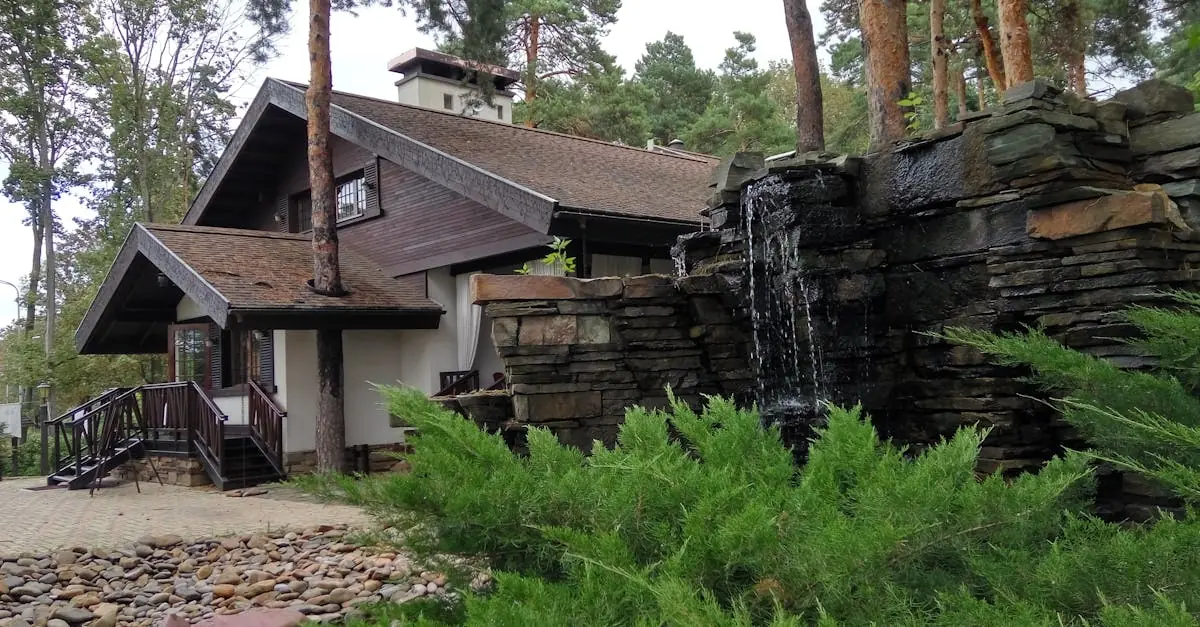Table of Contents
ToggleImagine transforming that patch of grass into a stunning retreat that even Mother Nature would envy. A backyard rock garden not only adds charm but also turns your outdoor space into a low-maintenance paradise. With the right mix of stones, plants, and creativity, it’s like giving your yard a makeover without the hefty price tag or a reality TV crew.
Overview Of Backyard Rock Gardens
Backyard rock gardens provide a stunning alternative to traditional landscaping. They incorporate various natural stones, gravel, and plants, creating visual interest and texture. Homeowners often choose these gardens for their low maintenance requirements and environmental benefits.
In designing a rock garden, selecting the right stones is crucial. Larger boulders can serve as focal points, while smaller pebbles fill spaces and offer contrast. Combining different types of rocks enhances the overall aesthetics, allowing creativity to shine.
Plant selection also plays a significant role in rock garden success. Drought-resistant plants, such as succulents and alpine species, thrive in rocky settings. Integrating ground covers like creeping thyme or moss enhances the garden’s appeal while reducing weed growth.
Additionally, rock gardens improve drainage and soil aeration. Strategically placing rocks allows rainwater to flow and prevent pooling in certain areas. This feature creates a healthier environment for the plants to flourish.
Adding features like pathways, benches, and decorative ornaments turns a standard garden into a serene retreat. Pathways made from flat stones invite exploration and connect various sections of the garden. Benches offer relaxation spots amidst the beauty, encouraging time spent outdoors.
Rock gardens also support biodiversity, attracting various insects and beneficial creatures. Pollinators like bees and butterflies are often drawn to the flowers, contributing to the local ecosystem. By fostering an inviting habitat, homeowners enjoy the natural interaction among wildlife.
Overall, backyard rock gardens create an enchanting space that combines beauty, functionality, and environmental advantages. Their distinct charm lies in their simplicity and versatility, appealing to diverse aesthetics and preferences.
Benefits Of Having A Rock Garden
Backyard rock gardens offer numerous benefits that enhance outdoor spaces. They bring visual interest, low maintenance, and functionality into any yard.
Aesthetic Appeal
Rock gardens create captivating landscapes through texture and natural forms. They provide a stunning backdrop for various plants, showcasing their colors and shapes. Large boulders serve as eye-catching focal points while smaller stones complement plant life. Well-placed stones and curated plants add layers, drawing the eye throughout the garden. Homeowners can personalize layouts, reflecting their unique styles and preferences. Additionally, rock gardens adapt well to different design themes, from modern minimalist to rustic chic.
Low Maintenance
Low maintenance advantages make rock gardens appealing for busy homeowners. These gardens typically require less water and fewer resources compared to traditional lawns. Drought-resistant plants thrive with minimal care. Weeds struggle to compete with rocky surfaces, allowing plants to flourish. Regular pruning and occasional watering suffice to maintain their beauty. Overall, homeowners appreciate the hassle-free nature of rock gardens, enjoying delightful outdoor spaces without the demanding upkeep often associated with traditional landscaping.
Designing Your Backyard Rock Garden
Designing a backyard rock garden involves careful planning and selection to create a harmonious landscape. Consider different elements that contribute to both aesthetics and plant health.
Choosing The Right Location
Choosing the right location is crucial for a thriving rock garden. Look for areas that receive ample sunlight, as most drought-resistant plants flourish in bright conditions. Avoid shaded spots where moisture retention can hinder plant growth. Observe the natural drainage patterns within the yard, ensuring water flows freely instead of pooling. Select a flat or gently sloping area to facilitate drainage and prevent erosion. Pay attention to accessibility for maintenance purposes; an easily reachable garden allows for convenient care and adjustments.
Selecting Rocks And Materials
Selecting rocks and materials influences the overall design and functionality of the garden. Use larger boulders as focal points, adding scales that draw the eye. Incorporate a variety of stone types such as granite, sandstone, and slate to enhance visual interest. Smaller stones, like gravel and pebbles, create a pleasing contrast and improve pathways. When choosing plants, opt for drought-resistant varieties that thrive in rocky settings, ensuring they complement the chosen materials. Additionally, consider other materials such as mulch for aesthetics and moisture retention, creating a balanced ecosystem that promotes healthy plant growth.
Plant Selection For Your Rock Garden
Selecting the right plants is essential for creating a thriving rock garden. Emphasizing drought-resistant varieties ensures a beautiful, low-maintenance landscape.
Drought-Resistant Plants
Drought-resistant plants perform exceptionally well in rocky environments. Succulents like Echeveria, Aloe, and Sedum thrive with minimal water needs. Alpine species such as dianthus and rockfoils also excel in these conditions, providing color while conserving resources.
Choosing these plants guarantees resilience against dry spells, reducing upkeep. Native perennials like lavender and yarrow require less water and enhance local biodiversity. Incorporating these options fosters a vibrant ecosystem while minimizing the need for irrigation.
Color And Texture Considerations
Incorporating various colors and textures enhances a rock garden’s appeal. Consider plant options with contrasting foliage; for example, combine silver-leaved plants like lamb’s ears with vibrant flowers like coreopsis.
This variety creates visual interest throughout the growing season. Additionally, layering plants with different heights adds depth. Taller plants like delphiniums can frame shorter varieties, ensuring a dynamic landscape. Seasonal blooms ensure continual visual change, making the space engaging year-round.
Maintenance Tips For Your Rock Garden
Regular upkeep ensures that a rock garden remains vibrant and attractive. Begin by checking for weeds, which may compete with chosen plants. Hand-pulling is effective for small infestations, while landscape fabric can prevent regrowth.
Watering needs vary, so it’s essential to observe plant moisture levels. Drought-resistant plants typically require minimal watering, but seasonal rainfall should guide irrigation frequency. During dry spells, deep watering encourages root growth and resilience.
Mulching serves multiple purposes. Using organic mulch not only suppresses weeds but also retains soil moisture. Applying a two-to-three-inch layer protects the roots during extreme temperatures.
Fertilizing contributes to plant health. Slow-release, organic fertilizers can invigorate growth without harming the ecosystem. Applying these in early spring before new growth starts offers the best results.
Inspecting stones for displacement is critical. As time passes, shifting stones may disrupt the garden’s design. Reseating misaligned stones helps maintain the desired aesthetic and stability.
Pruning encourages healthy plant growth and reshapes visual interest. Regular trimming of perennials promotes bushier plants and more blooms. Deadheading flowers also prolongs the blooming season.
Lastly, seasonal inspections can identify issues early. Checking for pests or diseases enables quick action to prevent spread. With attention and care, rock gardens can flourish, providing beauty and enjoyment year-round.
Creating a backyard rock garden offers homeowners a unique opportunity to enhance their outdoor space with beauty and practicality. By thoughtfully combining stones and drought-resistant plants, it’s possible to design a low-maintenance landscape that thrives with minimal effort.
These gardens not only improve aesthetics but also contribute to environmental sustainability by promoting biodiversity and reducing water usage. With careful planning and creativity, a rock garden can become a personal sanctuary that invites relaxation and exploration. Embracing this landscaping approach transforms ordinary yards into captivating retreats that reflect individual style and appreciation for nature.





